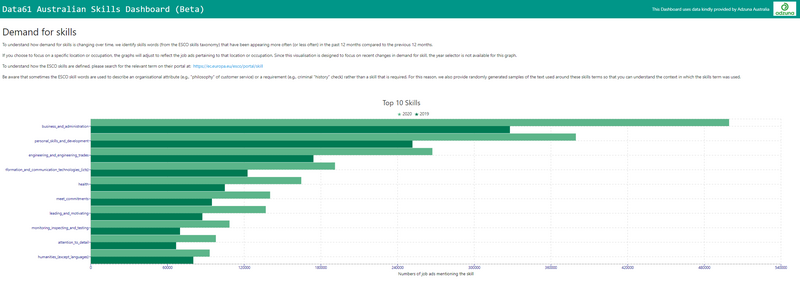ESCO testimonials: Australia's national research agency uses ESCO to upskill and reskill workers
ESCO testimonial

The following testimonial is part of a series of interviews conducted by the Commission with ESCO implementers. Their purpose is to shed a light on ESCO strengths and challenges as perceived by implementers, so that current and potential future stake
Tell us a bit more about your organisation and your research goals.
Within CSIRO’s Data61, the digital research arm of Australia’s national science agency, researchers are using ESCO to support the rapid upskilling and reskilling that is needed for Australian businesses and workers to engage with the economic opportunities created by emerging technologies. Technology developments tend to require workers to upskill and reskill rather than replacing humans altogether. Employers and workers need to focus on building the skills that are needed in this rapidly evolving labour market. In our research, we mine the vast amounts of data that are available in the digital age to gain insight into these skills trends.
How do you leverage ESCO in your projects and why is it valuable?
In this work we draw upon the ESCO skills framework. ESCO has been validated across all of the EU member states and provides a cross-national perspective on the types of skills that are needed in different occupations. Since we use machine learning and natural language processing in our work, it is also important that ESCO provides a hierarchy, written descriptions and labels for all 13,890 skills in the taxonomy. These features allow us to train algorithms to recognise when one or more of these ESCO skills is being described in text, whether that be text from a resume, text in a course description or text in a job advertisement. We used the ESCO taxonomy to build a Skills Dashboard in collaboration with Adzuna Australia. Adzuna Australia aggregate online job advertisements from more than a thousand sources in Australia. Within these job advertisements, employers describe what skills and attributes they seek from new workers. Using labels from the ESCO taxonomy, we can identify what skills are becoming more sought after by employers and what skills are becoming less sought after. We also allow users to see how these skill trends vary depending on the type of occupation being advertised, the geographic location of the job and the industry sector that the employer works in. Adzuna Australia have allowed us to share this valuable labour market data via our Skills Dashboard to assist government agencies, researchers, educators, students and workers to understand what skills are becoming more sought after in their region or line of work.

Figure 1: A visualisation from the Skills Dashboard showing demand for ESCO skills in Australian job ads
Even with information about skills trends, it can be difficult for employers and workers to determine how existing workers’ skills and experience align with new roles that are emerging in the labour market. The ESCO skills taxonomy provides a structure that supports better matching of demand and supply for labour. Working with Reejig, we developed an algorithm which identifies ESCO skills a job candidate has described in their resumé. Reejig now use this tool within their platform to efficiently find, hire and mobilise talent for some of Australia’s largest employers.
Do you also support curricula reforms based on ESCO? How does this work in practice?
Indeed, in a current project we use ESCO to evaluate the currency of vocational education and training courses. Using natural language processing, we can identify phrases in course descriptions that are similar to the ESCO skills descriptions. This matching allows us to train an algorithm to determine what skills are being delivered, across thousands of courses. Since ESCO also tells us what skills are needed in different occupations, we can use ESCO to flag when there may be a skills gap in the courses provided for Australian occupations. Sharing this information with the owners of training packages should help them to review the currency of their course offerings more efficiently.
The ESCO taxonomy provides a framework that allows the insights from all these projects to be joined up. Eventually, we plan to build a Knowledge Graph that shows how skills mentioned in job ads align with skills delivered in training courses and how workers can efficiently transition from one role to another. It is by providing a common framework and language that ESCO supports greater agility in our labour market.
